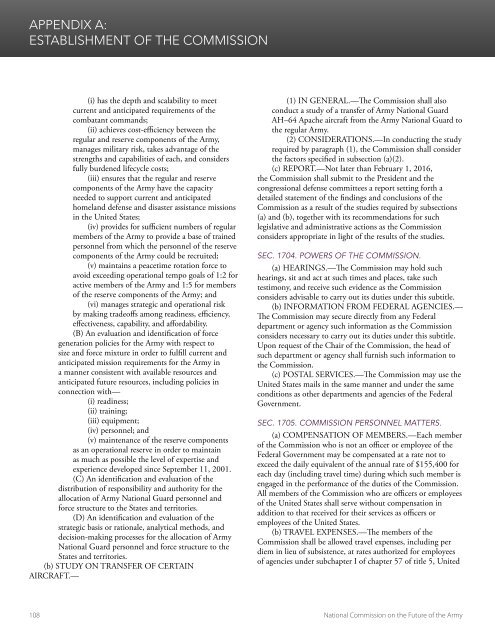THE FUTURE OF THE ARMY
Futurearmy
Futurearmy
You also want an ePaper? Increase the reach of your titles
YUMPU automatically turns print PDFs into web optimized ePapers that Google loves.
APPENDIX A:<br />
ESTABLISHMENT <strong>OF</strong> <strong>THE</strong> COMMISSION<br />
(i) has the depth and scalability to meet<br />
current and anticipated requirements of the<br />
combatant commands;<br />
(ii) achieves cost-efficiency between the<br />
regular and reserve components of the Army,<br />
manages military risk, takes advantage of the<br />
strengths and capabilities of each, and considers<br />
fully burdened lifecycle costs;<br />
(iii) ensures that the regular and reserve<br />
components of the Army have the capacity<br />
needed to support current and anticipated<br />
homeland defense and disaster assistance missions<br />
in the United States;<br />
(iv) provides for sufficient numbers of regular<br />
members of the Army to provide a base of trained<br />
personnel from which the personnel of the reserve<br />
components of the Army could be recruited;<br />
(v) maintains a peacetime rotation force to<br />
avoid exceeding operational tempo goals of 1:2 for<br />
active members of the Army and 1:5 for members<br />
of the reserve components of the Army; and<br />
(vi) manages strategic and operational risk<br />
by making tradeoffs among readiness, efficiency,<br />
effectiveness, capability, and affordability.<br />
(B) An evaluation and identification of force<br />
generation policies for the Army with respect to<br />
size and force mixture in order to fulfill current and<br />
anticipated mission requirements for the Army in<br />
a manner consistent with available resources and<br />
anticipated future resources, including policies in<br />
connection with—<br />
(i) readiness;<br />
(ii) training;<br />
(iii) equipment;<br />
(iv) personnel; and<br />
(v) maintenance of the reserve components<br />
as an operational reserve in order to maintain<br />
as much as possible the level of expertise and<br />
experience developed since September 11, 2001.<br />
(C) An identification and evaluation of the<br />
distribution of responsibility and authority for the<br />
allocation of Army National Guard personnel and<br />
force structure to the States and territories.<br />
(D) An identification and evaluation of the<br />
strategic basis or rationale, analytical methods, and<br />
decision-making processes for the allocation of Army<br />
National Guard personnel and force structure to the<br />
States and territories.<br />
(b) STUDY ON TRANSFER <strong>OF</strong> CERTAIN<br />
AIRCRAFT.—<br />
(1) IN GENERAL.—The Commission shall also<br />
conduct a study of a transfer of Army National Guard<br />
AH–64 Apache aircraft from the Army National Guard to<br />
the regular Army.<br />
(2) CONSIDERATIONS.—In conducting the study<br />
required by paragraph (1), the Commission shall consider<br />
the factors specified in subsection (a)(2).<br />
(c) REPORT.—Not later than February 1, 2016,<br />
the Commission shall submit to the President and the<br />
congressional defense committees a report setting forth a<br />
detailed statement of the findings and conclusions of the<br />
Commission as a result of the studies required by subsections<br />
(a) and (b), together with its recommendations for such<br />
legislative and administrative actions as the Commission<br />
considers appropriate in light of the results of the studies.<br />
SEC. 1704. POWERS <strong>OF</strong> <strong>THE</strong> COMMISSION.<br />
(a) HEARINGS.—The Commission may hold such<br />
hearings, sit and act at such times and places, take such<br />
testimony, and receive such evidence as the Commission<br />
considers advisable to carry out its duties under this subtitle.<br />
(b) INFORMATION FROM FEDERAL AGENCIES.—<br />
The Commission may secure directly from any Federal<br />
department or agency such information as the Commission<br />
considers necessary to carry out its duties under this subtitle.<br />
Upon request of the Chair of the Commission, the head of<br />
such department or agency shall furnish such information to<br />
the Commission.<br />
(c) POSTAL SERVICES.—The Commission may use the<br />
United States mails in the same manner and under the same<br />
conditions as other departments and agencies of the Federal<br />
Government.<br />
SEC. 1705. COMMISSION PERSONNEL MATTERS.<br />
(a) COMPENSATION <strong>OF</strong> MEMBERS.—Each member<br />
of the Commission who is not an officer or employee of the<br />
Federal Government may be compensated at a rate not to<br />
exceed the daily equivalent of the annual rate of $155,400 for<br />
each day (including travel time) during which such member is<br />
engaged in the performance of the duties of the Commission.<br />
All members of the Commission who are officers or employees<br />
of the United States shall serve without compensation in<br />
addition to that received for their services as officers or<br />
employees of the United States.<br />
(b) TRAVEL EXPENSES.—The members of the<br />
Commission shall be allowed travel expenses, including per<br />
diem in lieu of subsistence, at rates authorized for employees<br />
of agencies under subchapter I of chapter 57 of title 5, United<br />
108 National Commission on the Future of the Army


